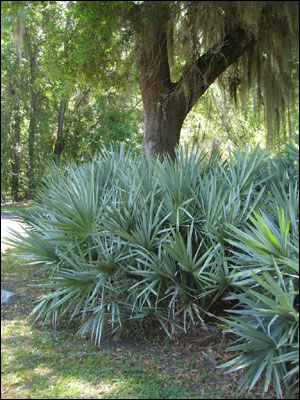Saw Palmetto
Saw palmetto grows wild in Florida’s natural areas, but it’s also a useful plant for home landscapes throughout the state.

This native plant tolerates a range of conditions and provides wonderful textural interest beneath new or established trees. And it’s highly salt-tolerant, making it ideal for coastal gardening. (It is important to note however, if you live in an area that needs to practice firewise landscaping, saw palmetto is not a good plant choice.)
Known scientifically as Serenoa repens, saw palmetto is native to the Southeast and can be found growing as far north as South Carolina and as far west as Texas.
Characteristics
Saw palmetto is a slow-growing, clumping, multi-trunked palm that typically grows 5 to 10 feet tall and spreads 4 to 10 feet wide. It has stout stems that usually crawl across the ground and produce fan-shaped fronds. While most forms have green leaves, leaf color is variable, with silver to blue-silver forms common on the east coast of Florida. In the horticultural trade, forms with more silvery foliage are sometimes given names including ‘Sericea’, ‘Cinerea’, or ‘Glauca’.
In the spring, 3-foot long flower stalks appear, sporting small yellow-white, fragrant flowers. Bees are attracted by these flowers, making high-grade saw palmetto honey. Flowers are followed by small, yellow berries that turn black and ripen August through October.
Saw palmetto is great for wildlife, as the berries are an important food source for many mammals and birds. Additionally, it is a host plant for the larvae of the palmetto skipper and monk butterflies. Some people believe that extracts from the berries could be an alternative treatment for prostate cancer, despite statements from the American Cancer Society that say there is no evidence of this. Because of increasing interest in the berries, a harvesting permit is now required to protect and preserve these plants. Anyone harvesting the berries must acquire a “Native Plant Harvesting Permit” issued through the Florida Department of Agriculture and Consumer Services (FDACS) Division of Plant Industry (DPI).
Planting and Care
It’s important to pick the right spot for planting, since saw palmetto can be difficult to move once established. Choose an area that will allow the plant room to grow and mature. Position plants away from walkways, driveways, play areas, or any place where the saw-like teeth along the stems might cause harm. This plant provides a beautiful backdrop for mixed borders and works well as a privacy hedge or foundation planting.
Saw palmetto prefers full sun but will grow in almost any light conditions. It will benefit from regular waterings at first, but will be very drought tolerant once established. Occasional pruning of dead fronds and old flower/fruit stems is all the maintenance this plant will need. Plants can be purchased in pots at many nurseries and can be planted year-round in Florida.
For more information on saw palmetto, contact your county Extension office.
